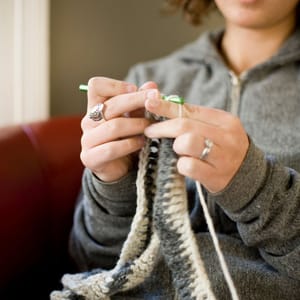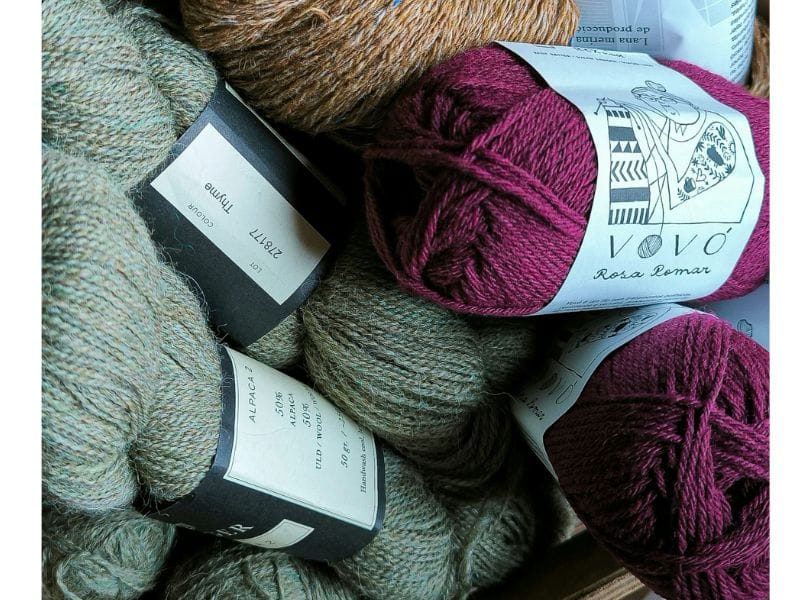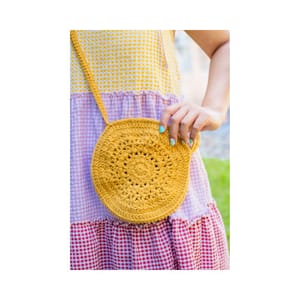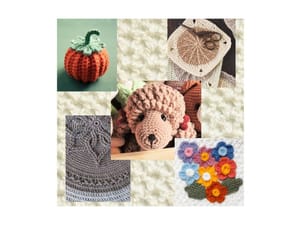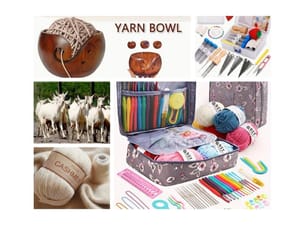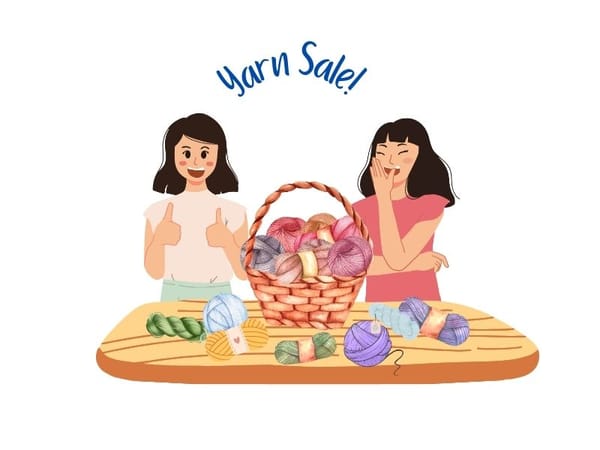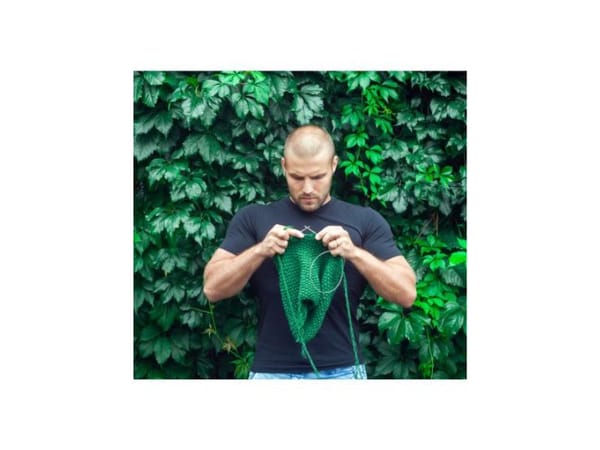Ever stood in the yarn aisle, staring at labels like they're written in a secret code?
Fear not, fellow yarn enthusiast! We're here to unravel the mystery of yarn labels and make you a yarn label-reading pro.
Understanding Yarn Labels: What is on a Yarn Label?
A yarn label is a valuable resource for knitters and crocheters, providing essential information about the yarn. Understanding what’s on a yarn label can help you make informed decisions when selecting yarn for your projects.
Here’s a breakdown of the typical components you’ll find on a yarn label:
- Brand and Yarn Name: The brand and specific name of the yarn can give you an idea of its quality and reputation.
- Color Name and Number: This helps you identify the exact shade of the yarn, ensuring consistency in your projects.
- Fiber Content: Knowing whether your yarn is made of wool, cotton, acrylic, or a blend is crucial for understanding its properties and suitability for different projects.
- Yarn Weight: This indicates the thickness of the yarn, which affects the size of your stitches and the overall look of your project.
- Yardage: This tells you how much yarn is in the skein, helping you calculate how much you need for your project.
- Gauge: This shows how many stitches and rows fit into a specific measurement, usually 4 inches, which is essential for achieving the correct size in your projects.
- Care Instructions: These symbols indicate how to wash, dry, and care for your finished project, ensuring it stays beautiful and lasts longer.
By familiarizing yourself with these components, you’ll be able to read yarn labels like a pro and choose the perfect yarn for every project.
The Fiber Content: Reading Yarn Labels to Know What's in Your Yarn
First things first, check the fiber content. This tells you what the yarn is made of.
Is it wool, cotton, acrylic, or a blend?
Each fiber has its own personality and quirks. And learning about fiber content will have you choosing the perfect yarn for every project!
- Wool: Warm and cozy, perfect for winter projects. Wool yarn is durable and suitable for various projects, but it's best to avoid it for lightweight items.
- Cotton: Breathable and soft, great for summer wear. Cotton yarn is machine washable and dryable, making it a practical choice for projects that require easier care.
- Acrylic: Versatile and budget-friendly, ideal for beginners.
Yarn Weight: The Goldilocks Factor
Yarn weight is crucial.
Yarn weight categories are standardized to help you choose the right weight yarn for your project.
The thickness of yarn is categorized on labels using a numbering system from 0 to 7, known as the yarn weight category. This is important for beginners as it affects project outcomes, including necessary needle size and potential gauge variations.
It determines the thickness of the yarn and affects the size of your stitches - no more mismatched projects!
The categories range from 0 (lace) to 7 (jumbo) and each category has a specific gauge range and recommended needle or hook size.
Also, look for terms like “lace,” “fingering,” “worsted,” and “bulky.”
- 0 (Lace): Ultra-fine, for delicate shawls, lacework, and intricate patterns.
- 1 (Super Fine): Great for socks and lightweight garments.
- 2 (Fine): Perfect for baby clothes and lightweight sweaters.
- 3 (Light): Ideal for light sweaters and accessories.
- 4 (Medium or Worsted): Medium weight and versatile for most projects, including Afghans and sweaters.
- 5 (Bulky): Thick and chunky, quick to work up, great for warm garments and accessories.
- 6 (Super Bulky): Perfect for chunky blankets and fast projects.
- 7 (Jumbo): Extra thick, for oversized projects and extreme knitting.
Yardage and Meterage: How Much Yarn Do You Need?
This tells you how much yarn is in the skein. It’s essential for planning your projects and ensuring you have enough yarn.
Calculate yardage like a pro so you no longer run out of yarn mid-project.
- Yardage: Measured in yards.
- Meterage: Measured in meters.
- More yardage means fewer skeins needed.
Gauge: The Secret to Perfect Fit
Knitting gauge indicates how many stitches and rows fit into a specific measurement, usually 4 inches, and is crucial for ensuring that finished projects are the right size. This means you should make a sample piece that measures 4 inches square. The suggested gauge provided on yarn labels guides users by indicating the recommended swatch size and needle or hook sizes for optimal results.
How to Make a Swatch to Measure Gauge
Creating a swatch to check for gauge is an essential step before starting any knitting or crocheting project.
To do this properly, start by selecting the yarn and needles or hook you'll be using for your project.
Cast on enough stitches to create a swatch that is at least 4 inches wide, as this will give you a more accurate measurement.
Knit or crochet in the pattern specified for your project until your swatch measures at least 4 inches in height.
Once completed, lay the swatch flat without stretching it and use a ruler to measure the number of stitches and rows per inch.
Compare these measurements to the gauge specified in your pattern. If your gauge matches, you're good to go!
If not, adjust your needle or hook size accordingly and create another swatch to recheck. This ensures your final project will have the correct dimensions and fit.
It’s vital for ensuring your project turns out the right size and your sweaters don't turn out to be too big or too small.
- Follow the recommended gauge for best results.
- Use a gauge swatch to check your gauge before starting. Understanding and creating a gauge swatch is crucial for achieving the desired project size and fit.
- You don’t want to be left missing a couple of feet of yarn because you made a swatch, so calculate the yarn you’ll be making the swatch out of too in case you keep it for repeat projects. If you don’t then unravel it and use that yarn in your project.
Care Instructions: Keep Your Creations Beautiful
Care instructions tell you how to wash and care for your finished project. Look for symbols indicating machine wash, hand wash, or dry clean.
You wouldn't want to ruin your newly made scarf by washing it incorrectly now, would you?
- Machine Washable: Easy care for everyday items.
- Hand Wash: Gentle care for delicate projects.
- Dry Clean: Professional care for special items.
Understanding Care Symbols
Care symbols on yarn labels are crucial for maintaining the quality and longevity of your finished projects. These symbols indicate how to wash, dry, and iron your yarn. Here’s a brief guide to common care symbols:
- Hand Wash Only: A tub with hands inside indicates that the yarn should be hand washed in cold water.
- Machine Wash Cold: A tub with a machine inside indicates that the yarn can be machine washed in cold water.
- Dry Flat: A square with a horizontal line indicates that the yarn should be dried flat, away from direct sunlight.
- Iron Low: An iron with a low temperature setting indicates that the yarn can be ironed on a low heat setting.
Understanding these symbols will help you keep your creations looking their best, wash after wash.
Dye Lot: Consistency is Key
Dye lot numbers ensure color consistency. Always buy enough of the same yarn from the same dye lot to avoid color variations in your project. Due to variations in dye processes, even yarns with the same name can differ in hue, which could lead to noticeable differences when multiple skeins are used together. Consulting with local yarn shops can help ensure color consistency.
The last thing we want is weird color patches in the blanket your crocheted for grandma!
- Check dye lot numbers before purchasing.
- Buy extra yarn to avoid running out.
Yarn Brand and Name: Trustworthy Choices
The brand and name can give you an idea of the yarn’s quality and reputation. Trusted brands often have consistent quality.
You will quickly learn which are your favorites to work with, and they don't necessarily need to break the bank.
- Research brands for reliability.
- Try different brands to find your favorite.
Country of Origin: Know Your Yarn’s Roots
The country of origin can indicate the quality and type of fiber used. Some countries are known for specific types of yarn.
It can be fun knowing where your yarn comes from. If you have an Italian Nonna, you may prefer using an Italian yarn to make her a scarf for Christmas or her birthday.
- Italian yarns: Known for luxury and quality.
- Peruvian yarns: Famous for alpaca and wool.
Suggested Needle/Hook Size: The Perfect Match
The label often suggests a needle or hook size - no more guessing which to use! The type and size of knitting needles can affect individual tension and gauge, which are critical for accurately determining the amount of yarn needed for a project.
This helps you achieve the recommended gauge and makes your project easier to work on. It's important to understand the recommended gauge and needle sizes for a particular yarn, as these suggestions can vary based on individual tension and the specific project being undertaken.
- Follow the suggested size for best results.
- Adjust size if your gauge is off.
Special Features: Extra Perks
Some yarns have special features like being hypoallergenic, eco-friendly, or having a unique texture. Sock yarn, for example, typically consists of 75% superwash wool and 25% nylon, making it ideal for various knitting projects due to its durability and elasticity. These can add extra value to your project.
- Hypoallergenic: Great for sensitive skin.
- Eco-friendly: Good for the environment and a sustainable choice.
- Unique textures: Add flair to your projects.
Color Name and Number: Matching and Selecting Yarns
When working on a project, it’s essential to match the yarn color and dye lot to ensure consistency. Here’s how to match and select yarns:
- Check the Color Name and Number: Always check the color name and number on the yarn label to ensure you’re using the same color.
- Look for the Dye Lot Number: The dye lot number indicates the batch of yarn dyed at the same time. Using yarn from the same dye lot ensures color consistency.
- Purchase from the Same Dye Lot: If you’re using multiple skeins, try to purchase them from the same dye lot to avoid color variations.
- Matching Colors: If you’re unable to find yarn from the same dye lot, compare the yarn labels or create a swatch to match the color as closely as possible.
By paying attention to these details, you can ensure your projects have a uniform and professional look.
What to Do if You Lost the Yarn Label
Losing a yarn label can be frustrating, but there are ways to determine the yarn’s weight, fiber content, and care instructions. Here are some tips:
- Examine the Yarn’s Texture and Fiber Content: You can often identify the fiber content by its feel. For example, wool yarns are typically warm and slightly coarse, while cotton yarns are soft and breathable.
- Use the Wraps Per Inch Method: Wrap the yarn around a ruler for one inch and count the number of wraps. This can help you estimate the yarn weight.
- Analyze the Yarn’s Characteristics: Look for specific characteristics such as softness, durability, or texture to help identify the fiber content.
- Consult Online Resources or Experts: There are many online resources and yarn experts who can help you identify your yarn based on its appearance and feel.
By using these methods, you can still make the most of your yarn and complete your projects successfully, even without the original label.
By understanding what’s on a yarn label and how to match and select yarns, you’ll be better equipped to choose the right yarn for your projects and ensure they turn out beautifully.
There you have it, the ultimate guide to reading yarn labels!
Now that you know how to read yarn labels, go forth and conquer the yarn aisle with confidence.
Happy knitting and crocheting!







Images Source: Unsplash

